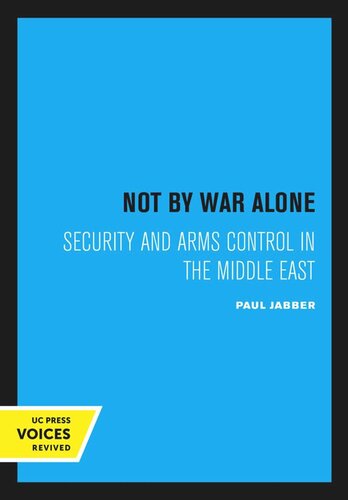

Most ebook files are in PDF format, so you can easily read them using various software such as Foxit Reader or directly on the Google Chrome browser.
Some ebook files are released by publishers in other formats such as .awz, .mobi, .epub, .fb2, etc. You may need to install specific software to read these formats on mobile/PC, such as Calibre.
Please read the tutorial at this link. https://ebooknice.com/page/post?id=faq
We offer FREE conversion to the popular formats you request; however, this may take some time. Therefore, right after payment, please email us, and we will try to provide the service as quickly as possible.
For some exceptional file formats or broken links (if any), please refrain from opening any disputes. Instead, email us first, and we will try to assist within a maximum of 6 hours.
EbookNice Team

Status:
Available4.7
29 reviews
ISBN-10 : 0520311477
ISBN-13 : 9780520311473
Author: Paul Jabber
The Middle East remains the most politically volatile and militarily unstable region in the world. It is also in relative terms the most heavily armed; and the influx of American, Soviet, French and other weaponry continues unabated. Moreover, the Arab-Israeli conflict invites competition in nuclear armaments. Accordingly a concern of public policy must be the promotion of strategic stability between potential adversaries and the imposition of effective restraints on the several interrelated arms races in the region. In the absence of negotiated solutions to existing disputes, or as a feature of future peace accords, arms-control measures could be of crucial importance in preventing the outbreak of war. Jabber explores the prospects for arms control in the specific contexts of the Arab-Israeli dispute and of military developments since the war of October 1973. Seeing lessons from history, and drawing on previously untapped materials, he includes a case-study of an actual Middle East arms-control system that was instituted by the United States, Great Britain, and France under the Tripartite Declaration of May 1950. Designed to prevent further warfare after the establishment of Israel by maintaining a stable balance of power through the rationing of arms supplies, this agreement was soon circumvented by its French sponsors, and it collapsed altogether following the emergence in 1955 of the Soviet Bloc as a major source of arms.
CHAPTER 1 INTRODUCTION
CHAPTER 2 PROBLEMS AND PROSPECTS FOR ARMS CONTROL IN THE ARAB-ISRAELI CONFLICT
ENDURING ELEMENTS OF MILITARY INSTABILITY
STRATEGIC IMPACT OF THE 1973 WAR
ACROSS THE NUCLEAR THRESHOLD?
THE OUTLOOK FOR ARMS CONTROL
CHAPTER 3 MULTILATERAL APPROACHES TO ARMS-TRANSFER LIMITATION
THE RELEVANCE OF ARMS CONTROL
PAST MULTINATIONAL EFFORTS TO CONTROL THE TRANSFER OF ARMS
REGIONAL ARMS CONTROL
CHAPTER 4 SUPPLY AND CONTROL: ARMS AND THE TRIPARTITE DECLARATION OF MAY 1950
THE BACKGROUND OF POLICY
THE “PENTAGON TALKS” OF 1947
TERRITORIAL GUARANTEES AND REGIONAL SECURITY
THE ARMS ISSUE
THE DECLARATION TAKES SHAPE
CHAPTER 5 OPERATIONAL ASPECTS OF THE ARMS CONTROL SYSTEM
WESTERN ARMS SUPPLY POLICIES, 1950-1955
THE NEAR EAST ARMS COORDINATING COMMITTEE
THE “ARMS BALANCE”
THE REGIONAL IMPACT OF THE TRIPARTITE POLICY
CHAPTER ARMS FOR EGYPT: THE LITMUS TEST
NASSER’S FIRST BID FOR U.S. ARMS: THE SABRI MISSION
PROMISES TO KEEP: NASSER’S SECOND BID
CHAPTER 7 THE USE AND MISUSE OF ARMS CONTROL
BASIC SHORTCOMINGS OF THE TRIPARTITE REGIME
THE POLITICS OF ARMS CONTROL
IN SEARCH OF STRATEGIC STABILITY
SELECTED BIBLIOGRAPHY
not by alone
not war but love
never be alone war
war not war ian anderson
war not war boondock saints
Tags: War Alone, Security, Arms Control, the Middle East, Paul Jabber